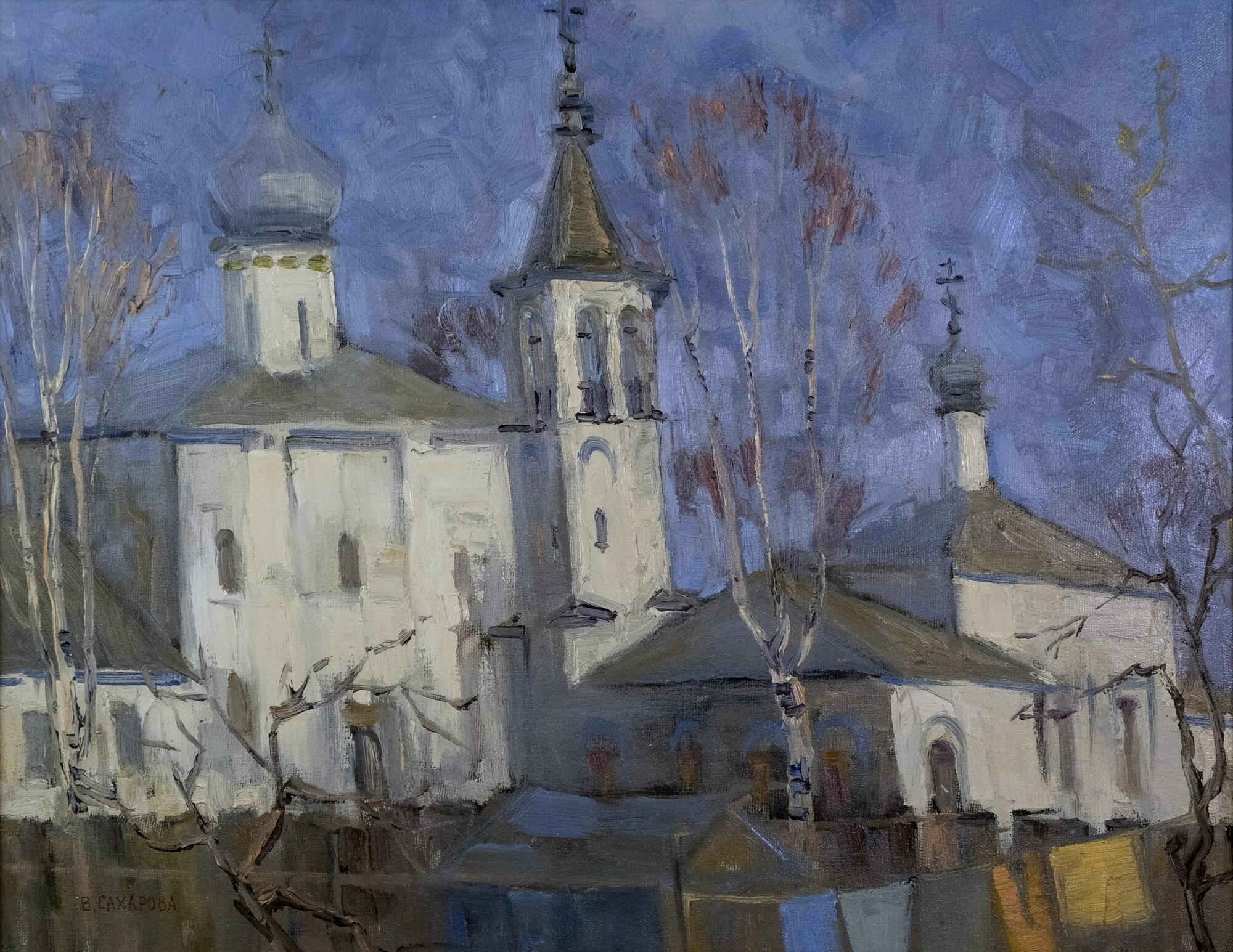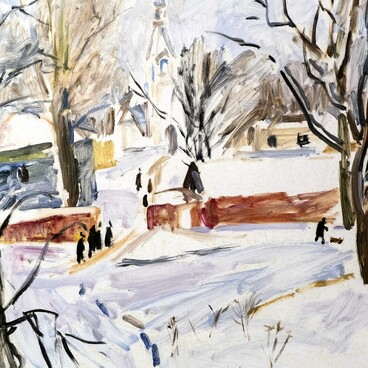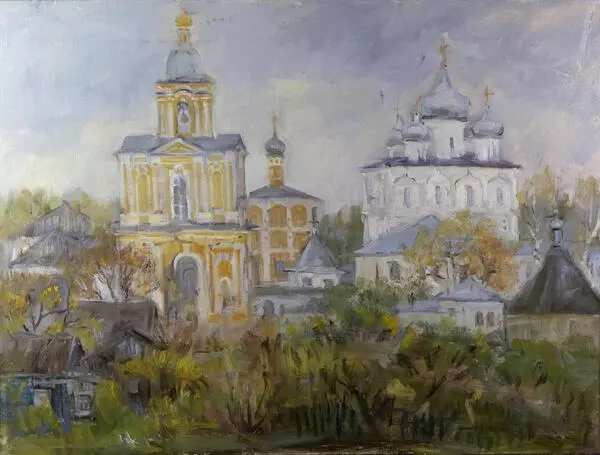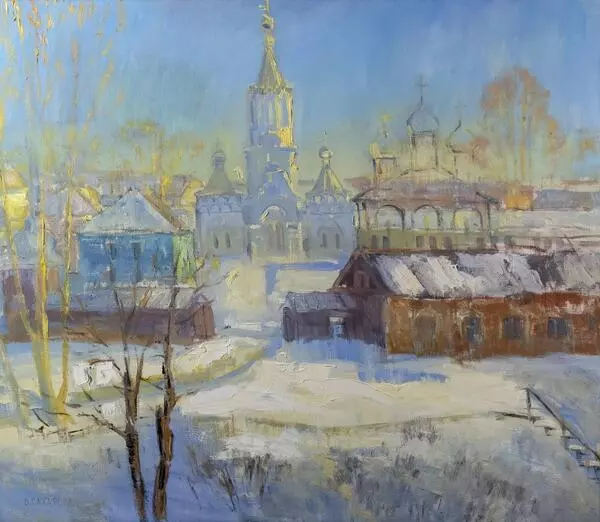The Trade Side of Novgorod was replete with churches and monasteries. One of them was the Mikhalitsky Nunnery in the Carpenter’s End of the city (Veliky Novgorod was divided into boroughs, or — “ends”), where Molotkovskaya Street now runs.
The monastery was founded in 1199 by the wife of Prince Yaroslav Vladimirovich, Princess Elena. According to legend, she fulfilled the commandment of Saint Michael Maleinos, who appeared to her twice. It is likely that the nunnery was named Mikhalitsky in his honor. There is another legend explaining the location of the monastery. A parishioner came home from church with a prosphoron wrapped in a handkerchief and fell asleep. Some runaway dogs wanted to snatch the prosphoron from his hands, but “fire came out” from it. After that, Archbishop Martyrius blessed the construction of the monastery at the place where the miracle occurred.
Initially, a wooden church of the Nativity of the Virgin was erected. It stood until 1377, when it was struck by lightning. Two years later, a new stone church was built on the site of the burned-down one. In 1534, it also suffered in a fire: the crosses, icons and various church utensils were burned. The Novgorod Third Chronicle says that another stone church with an attached refectory appeared there in 1555 and was consecrated in honor of the Annunciation.
In 1615, according to written sources, there were two stone churches in the Mikhalitsky Nunnery — the Church of the Nativity with the chapel of St. Simeon of the Admirable Mountain and the Cathedral of the Theotokos with a refectory. During the capture of Novgorod by the Swedes, they were damaged, like many other Novgorod churches.
The local historian Ruf Gavrilovich Ignatiev managed to discover a chronicle that was written in the Mikhalitsky monastery in the 17th century; it is believed that the author of the Zabelinsky Chronicle used it as a source (no later than 1681). At the end of the century, the Church of the Nativity of the Theotokos was rebuilt; a western narthex, stone crosses embedded in the walls and ceramic tiles under the dome were added.
In 1764, the monastery was closed, but in 1775 it was reopened when the sisters of the burned-down St. Nicholas Sokolnitsky Nunnery needed a new home. In 1786, the monastery churches were transferred to parishes, and in the mid-19th century there were about 30 parishioners in the Nativity Church.
In the 1920s–1930s, the church was closed. In the middle of the 20th century, after the events of the Great Patriotic War, the monastery was reconstructed to its 17th century appearance, and some architectural details were restored to their 14th century state. The project was developed by Leonid Yegorovich Krasnorechyev.
The monastery was founded in 1199 by the wife of Prince Yaroslav Vladimirovich, Princess Elena. According to legend, she fulfilled the commandment of Saint Michael Maleinos, who appeared to her twice. It is likely that the nunnery was named Mikhalitsky in his honor. There is another legend explaining the location of the monastery. A parishioner came home from church with a prosphoron wrapped in a handkerchief and fell asleep. Some runaway dogs wanted to snatch the prosphoron from his hands, but “fire came out” from it. After that, Archbishop Martyrius blessed the construction of the monastery at the place where the miracle occurred.
Initially, a wooden church of the Nativity of the Virgin was erected. It stood until 1377, when it was struck by lightning. Two years later, a new stone church was built on the site of the burned-down one. In 1534, it also suffered in a fire: the crosses, icons and various church utensils were burned. The Novgorod Third Chronicle says that another stone church with an attached refectory appeared there in 1555 and was consecrated in honor of the Annunciation.
In 1615, according to written sources, there were two stone churches in the Mikhalitsky Nunnery — the Church of the Nativity with the chapel of St. Simeon of the Admirable Mountain and the Cathedral of the Theotokos with a refectory. During the capture of Novgorod by the Swedes, they were damaged, like many other Novgorod churches.
The local historian Ruf Gavrilovich Ignatiev managed to discover a chronicle that was written in the Mikhalitsky monastery in the 17th century; it is believed that the author of the Zabelinsky Chronicle used it as a source (no later than 1681). At the end of the century, the Church of the Nativity of the Theotokos was rebuilt; a western narthex, stone crosses embedded in the walls and ceramic tiles under the dome were added.
In 1764, the monastery was closed, but in 1775 it was reopened when the sisters of the burned-down St. Nicholas Sokolnitsky Nunnery needed a new home. In 1786, the monastery churches were transferred to parishes, and in the mid-19th century there were about 30 parishioners in the Nativity Church.
In the 1920s–1930s, the church was closed. In the middle of the 20th century, after the events of the Great Patriotic War, the monastery was reconstructed to its 17th century appearance, and some architectural details were restored to their 14th century state. The project was developed by Leonid Yegorovich Krasnorechyev.





